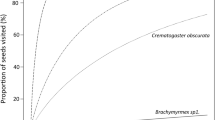Abstract
A number of volatile compounds occur on the seeds of taxonomically unrelated ant-garden epiphytes in western Amazonia. In field trials in southeastern Peru, we assayed the responses of ant-garden ants (Camponotus femoratus) to these and structurally similar compounds applied to artificial “seeds” made from zeolite molecular sieves. Benzothiazole,2, present on seeds of eight ant-garden epiphytes, repelled ants over the range of concentrations tested, as did 1-(2-hydroxy-6-methylphenyl)ethanone,3, occurring on seeds of six ant-garden epiphytes. 2-Hydroxy-6-methylbenzoic acid, methyl ester (methyl-6-methylsalicylate, 6-MMS),1, found on seeds of at least nine ant-garden epiphytes, was mildly repellent at high concentration, but stimulated excitement, seed handling, and (rarely) seed carrying at lower concentrations. Vanillin,5, a seed compound of four ant-garden epiphytes, and limonene,6, a monoterpene from seeds of three ant-garden epiphytes, both stimulated excitement, alarm, seed handling, and (rarely) seed carrying. Identified from seeds of seven ant-garden epiphytes, 1-(2,4-dihydroxyphenyl)ethanone,4, elicited little or no response. Among 70 compounds tested (mainly aromatic compounds), those found on seeds of ant-garden epiphytes or having structural features in common with such compounds were the most attractive to the ants. Although not present on epiphyte seeds, 2-hydroxy-3-methoxybenzenemethanol,10, consistently stimulated seed transport to the nest in one year, but did so only rarely in subsequent years. Some of the volatile compounds on seeds of ant-garden epiphytes probably play a role in ant attraction to epiphyte seeds, but evidence remains ambiguous. Finally,Ca. femoratus responded to one test compound [1-(2-hydroxy-4-methoxyphenyl)ethanone,60] (absent from epiphyte seeds) by descending from the vegetation to the ground.
Similar content being viewed by others
References
Amstutz, E.D. 1949. The reaction ofo-veratronitrile with methylmagnesium iodide.J. Am. Chem. Soc. 71:3836–3837.
Auwers, K., Lechner, M., andBundesmann, H. 1925. Zur kenntnis der Beckmannschen umlagerung (III.).Chem. Ber. 58:36–51.
Blum, M.S., Jones, T.H., Snelling, R.R., Overal, W.L., Fales, H.M., andHighet, R.J. 1982. Systematic implications of the exocrine chemistry of someHypoclinea spp.Biochem. Syst. Ecol. 10:91–94.
Covert, L.W., Connor, R., andAdkins, H. 1932. The use of nickel as a catalyst for hydrogenation. II.J. Am. Chem. Soc. 54:1651–1653.
Davidson, D.W. 1988. Ecological studies of Neotropical ant-gardens.Ecology 69:1138–1152.
Davidson, D.W., andEpstein, W.W. 1989. Epiphytic associations with ants, chapter 8in U. Lüttge (ed.). Vascular Plants as Epiphytes. Springer-Verlag, New York.
Dunning, B., Jr., Dunning, F., andReid, E. 1936. A study of some substituted hydroxy benzyl alcohols.J. Am. Chem. Soc. 58:1565–1568.
Hanus, F. 1940. Die Kondensation vono-Kresol mit Formaldehyd in alkalischer Lösung.J. Prackt. Chem. 155:317–321.
Holshouser, M.H., andKolb, M. 1986. Facile synthesis of glycol metabolites of phenethylamine drugs.J. Pharm. Sci. 75:619–621.
Klimes, I., andLamparsky, D. 1976. Vanilla volatiles-a comprehensive analysis.Int. Flavors Food Addit. 7:272–273.
Kuiters, A.T. 1989. Effects of phenolic acids on germination and early growth of herbaceous woodland plants.J. Chem. Ecol. 15:467–479.
Rao, A.V.R.,Deshmukh, M.N., andSivadasan, L. 1981. A simple procedure for the preparation of methyl esters.Chem. Ind. (London) 164.
Seidel, J.L. 1988. The monoterpenes ofGutierrezia sarothrae: Chemical interactions between ants and plants in neotropical ant-gardens. Dissertation. University of Utah, Salt Lake City, Utah.
Seidel, J.L., Epstein, W.W., andDavidson, D.W. 1990. Neotropical ant gardens: I. Chemical constituents.J. Chem. Ecol. 16:1791–1816.
Wittig, G., andSchulze, W. 1931. Zur Kenntnis der Chinitrole.J. Prackt. Chem. 130;81–91.
Author information
Authors and Affiliations
Rights and permissions
About this article
Cite this article
Davidson, D.W., Seidel, J.L. & Epstein, W.W. Neotropical ant gardens II. Bioassays of seed compounds. J Chem Ecol 16, 2993–3013 (1990). https://doi.org/10.1007/BF00979490
Received:
Accepted:
Issue Date:
DOI: https://doi.org/10.1007/BF00979490
Key Words
- Ant
- ant-garden
- benzothiazole
- Camponotus
- Hymenoptera
- Formicidae
- chemical mimicry
- epiphyte
- 2-hydroxy-3-methoxybenzene-methanol
- 1-(2-hydroxy-4-methoxyphenyl)ethanone
- 2-hydroxy-6-methyl-benzoic acid
- methyl ester
- 1-(2-hydroxy-6-methylphenyl)ethanone
- 1-(2,4-dihydroxyphenyl)ethanone
- limonene
- 6-methyl-methylsalicylate
- 6-MMS
- seed dispersal
- symbiosis
- tropical forests
- vanillin




